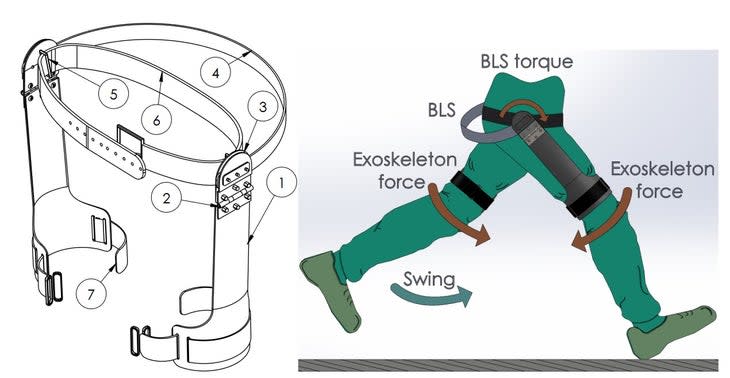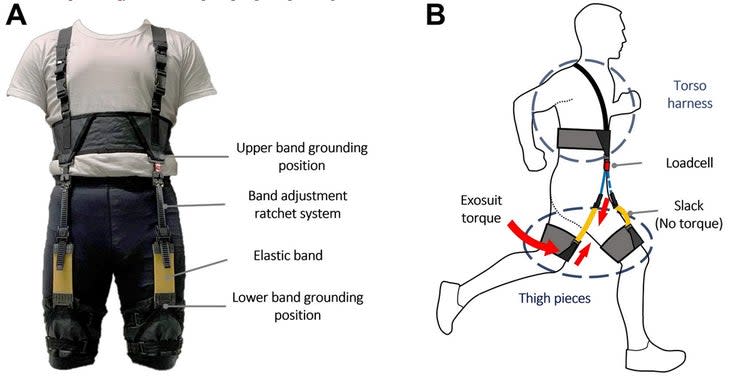Are Superpants the Next Supershoes?
Back in 2018, when the running world was flipping its collective lid over a shoe that made runners four percent more efficient, a trio of researchers from the University of Tehran in Iran published a little-noticed paper in the journal IEEE Transactions on Neural Systems and Rehabilitation Engineering that promised an eight percent savings. The trick was a spring-loaded exoskeleton, worn around the waist and clamped to the upper legs, that helped swing the rear leg forward with each stride.
Rodger Kram, the University of Colorado researcher whose lab performed the initial testing of Nike's Vaporfly 4% shoe, tipped me off about the paper--with, I suspect, a twinkle in his eye, given all the controversy sparked by the Vaporfly results. I thought the paper was interesting, but mostly as a novelty. The design was a little too cumbersome, and the spring a little too springy, for me to imagine that anyone would actually use it, much less that it would be deemed legal for competition by World Athletics. Here's what the prototype looked like:

The goal of producing simple wearable exoskeletons to assist walking or running has been around for years, and most of the initial designs focused on powered Robocop-style exoskeletons for walking, particularly while carrying heavy loads. The military was understandably interested. But running is very different from walking, and until the Iranian paper there hadn't been much progress in developing a practical assistive device.
Since then, though, the field has taken off. One of the most interesting advances was a 2019 paper from a group at Stanford University, led by Jessica Selinger (now at Queen's University) and Elliot Hawkes (now at UC Santa Barbara). Their design was incredibly simple: tying the runner's shoes together with an elastic band. Literally, that's what they did, using latex surgical tubing that they dubbed an "exotendon." Here's what it looked like:

The payoff? A 6.4 percent improvement in running economy (i.e. reduction in the energy required to run at a given pace). That's amazing--but not especially practical for taking out into the real world, thanks to the trip hazard. Another caveat is that the running speed in the experiment was 10 minutes per mile. That's similar to the testing speed in the other experiments described here, but a long way from, say, elite marathon pace.
There's an interesting wrinkle to the Stanford paper. The current best estimate is that swinging your legs forward with each stride takes only about seven percent of the energy you spend running. The vast majority of the energy--65 to 82 percent, according to the paper--is wasted braking your center of mass when your foot slams into the ground and then reaccelerating it when you push off. So how does an elastic band save 6.4 percent of your energy? By shifting the runners to a higher cadence, which reduces those braking-and-reaccelerating costs. (I'm glossing over a bunch of details here, but the key takeaway is that the energy savings are not just about pulling the back leg forward, even though that's exactly what the elastic band is doing. You can read a more detailed discussion in the paper, which is freely available online.)
Meanwhile, the beat goes on. Last June, a research group in China published details of another unpowered hip exoskeleton that improved running economy by 7.2 percent. And in August, in the Journal of NeuroEngineering and Rehabilitation, a group in South Korea led by Giuk Lee of Chung-Ang University shared details of a design that saved either 2.5 or 4.7 percent, depending on how you do the statistics. The lower number is probably the most accurate--which may make you wonder why I'm even bothering to mention it, since the previous papers were producing 6- to 8-percent improvements.
Here's why:

That's the design of the South Korean exoskeleton. You wear a little band around your torso, held up by suspenders. And you have one compression band around each thigh, connected to the torso band by an elastic. That's it. It's super light, weighing just 1.3 pounds. It sticks out from the body no more than an inch. It's getting very, very close to being a pair of high-end compression half-tights. And that (or at least a successor design) is something that I could imagine someone trying out in competition, and that is less obviously in contravention of World Athletics rules.
I asked a World Athletics spokesperson whether this is on their radar. She pointed me to the catch-all rules about technical assistance, which include Rule 6.3.3 forbidding "the use of any technology or appliance that provides the user with an advantage which they would not have obtained using the equipment specified in, or permitted by, the Rules"; and Rule 6.3.4 forbidding "the use of any mechanical aid."
That does seem to me to preclude the use of most of the exoskeletons I've described above. But I can't help remembering that, when carbon-plated shoes were introduced, the relevant shoe rule at the time forbade "the incorporation of any technology which will give the wearer any unfair advantage." Many people felt that this should have ruled out the Vaporfly's carbon-fiber plates. But Nike's position was that a stiff plate in the midsole was something that many previous running shoes had incorporated without any objections.
That's the kind of gray area I could imagine a pair of tight, stretchy compression shorts falling into. After all, numerous studies have investigated whether existing compression garments improve running economy, and a few of them have even produced positive results. What makes a hypothetical pair of elasticized shorts different?
I asked Rodger Kram what he would suggest. His answer wasn't simple, because he wanted to ensure that any new rule wouldn't have unintended consequences on shoe design or on the prosthetics used by athletes with leg amputations. In fact, he'd love to see prominent events like the X Games, the Fifth Avenue Mile, or even the Boston Marathon include special exoskeleton-permitted races as a way of spurring innovation in assistive mobility devices. But for elite track competition, his suggested rule was as follows: "No elastic or powered devices acting above the feet that reduce the metabolic cost of running or enhance maximal acceleration or top speed of the athlete shall be allowed."
What got me thinking about all this was a World Athletics announcement in late December about their newly revised shoe rules. Among them was an upper limit of 20 millimeters for the thickness of track spikes, down from the current 25 millimeters, which will go into effect in November 2024. That's exactly the kind of post hoc regulation you want to avoid: a new class of shoe appears, wipes out a swath of world records and sweeps the table at the Olympics... and you belatedly announce that they'll be banned starting in a couple of years. I don't know if elasticized half-tights are ever going to be a difference-maker in world-class competition. But just to be safe, now might be a good time to write them into the rules.
For more Sweat Science, join me on Twitter and Facebook, sign up for the email newsletter, and check out my book Endure: Mind, Body, and the Curiously Elastic Limits of Human Performance.

